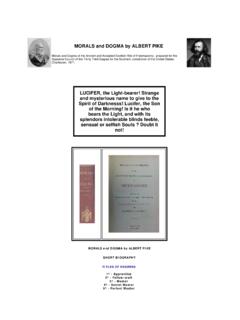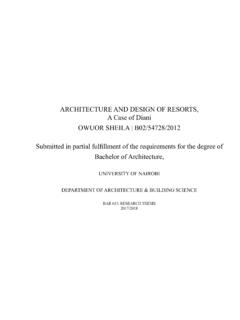Transcription of Glossary of Architectural Terms - Bradford
1 Glossary of Architectural Terms Apex: The highest, pointed part of a gable. Apron: A raised panel below a window or opening. Arcading: A series or row of arches. Architrave: The lowest part of the entablature. The term is also commonly used to describe a moulded surround to a door or window opening. An eared architrave has the surround turning outwards, then upwards before returning horizontally along the top of the opening it is framing. Archivolt: Bands or mouldings surrounding an arched opening. Art Deco: An Architectural style which was fashionable during the 1920s and 30s. The movement some times used modern materials such as cast concrete and the style suggested modernity, technology and motion. Stained and leaded glass was sometimes used and is often of a creative, geometric design.
2 Art Nouveau: A style of art and architecture which came into prominence in Paris in 1895. It was a break away from past styles of decoration and drew inspiration from natural forms such as plants and waveforms. Its influence is visible in some Arts and Crafts and Edwardian buildings, particularly in Terms of decorative glazing and interiors. The movement lost its momentum by 1914. Arts and Crafts: Late 19th and early 20th century Architectural style cased on the revival of traditional crafts (such as carpentry, glassmaking etc) and natural materials. Ashlar: Dressed stonework of any type, where the blocks have squared sides, carefully squared corners, and are laid in regular courses, usually with fine joints. The faces of the stones, called ashlars, are generally smooth and polished, but can be tooled or have a decorative treatment.
3 Astragal: A wooden glazing bar which divides a window. Can be functional and straight, as on a sash window, or curved and decorative. Balustrade: a parapet or stair rail composed of uprights (balusters) carrying a coping or railing. Bargeboards: boards fixed at the gable ends of roofs to conceal and protect the ends of the roof timbers. They may project over the wall face and are frequently highly decorative Baroque/neo-Baroque: An exuberant style of art and architecture prevalent in the 17th and 18th centuries, but largely confined to mainland Europe with very few examples in Yorkshire or indeed Britain. This style reappeared in England around 1900 and had a short-lived revival. Batter: The inclined surface of a wall, most pronounced at the base.
4 Battlement: A parapet with upstanding pieces and indentations (called crenels). Castellated, like the turrets and defensive walls of castles. Bay Window: A window which projects on the outside of a building. A canted bay window has a flat front and angled sides. Bays: The number of windows in a horizontal line across a fa ade. Blind Opening: A term applied to windows, arches, balustrades etc that are applied to a wall for decorative purposes but are blocked with recessed stone, brick etc. Blocking course: a plain course forming a low parapet on top of the cornice, usually concealing a gutter. Bow: a curved wall or window is said to be bowed. Bracket: Any projection from the face of a wall whose purpose is to support a structure or object.
5 Broached: At the point where an octagonal spire meets a square tower, the four angles of the tower not covered by the base of the spire are filled by an inclined mass of masonry known as the broach. Broken Pediment: A pediment with an incomplete or missing base is said to be broken. Buttress: A mass of masonry built against or projecting from a wall either to stabilise, from the lateral thrust of an arch roof or vault, or to enable the wall to be thinner. Campanile: A bell tower, usually free standing. 275 Capital: The crowning feature or head of a column, pilaster or gate pier. Capping: Although it can occupy the same position as a moulding ( around the edge of a panel, or as part of an entablature), a capping is where the stone is carved with an ornate repeated pattern rather than being given a decorative profile.
6 Also another word for a capital. Casement window: A window which is side hung to open outwards or inwards on hinges. Chamfer: Narrow face created when the edge of a corner in stonework is cut at an angle, usually 45 degrees, but sometimes concave or convex. Where two corners of stonework have been cut away, a double chamfer is created. Chancel: The chancel is the continuation of the nave of a church to the east of the crossing. Inside, it is where the altar stands. Cill or Sill: The horizontal feature at the bottom of a window or door which throws water away from the face of a building. Cill Band: A projecting horizontal band which connects cills across the face of a wall. Clasped Buttresses: Clasped buttresses support the ends of the walls at either side of a corner and adjoin each other at a right angle.
7 Classical Architecture: The employment of the symmetry and system of proportioning used in ancient Greek and Roman architecture which was revived in the Renaissance and was popular in England during the 18th and 19th centuries. English Classical or neoclassical buildings have a regular, formal appearance and symmetrical facades and might also incorporate Classical details such as an entablature at the wall top or pilasters dividing bays. This revival also sometimes incorporated the five orders of architecture which vary in Terms of the system of proportioning and degree of the decoration. Colonette: A small, column-like shaft. Column: An upright vertical member which usually stands clear of the main body of a building.
8 Usually circular in cross-section and is a common motif of Classic architecture. Composite: Invented by the Romans as a mixture of Ionic and Corinthian orders, the Composite is the largest and most heavily decorated orders of Classical architecture. Console: An ornamental scrolled bracket, normally in stone or timber, usually supporting a projecting lintel, fascia. Coping(stone): Top course of a wall designed to prevent water penetrating into the core of the wall. Copes are often shaped half - round or saddle - backed, and can frequently be quite decorative. Tabled coping usually refers to a flat copingstone. Tabled coping is usually seen on a gable end of a building as opposed to on a freestanding wall. Corbel: A projecting block which supports a parapet or sill.
9 Often carved, particularly in Gothic Architecture, where heads and foliage are common. Corinthian: The largest of the five orders of Roman Classic Architecture, which was also employed in British Classicism. The capitals of columns and pilasters have an acanthus leaf decoration and the entablature is heavily decorated with a deep cornice supported by modillions. Cornice: The top course of a wall or Architectural member (such as a doorcase) which is sometimes moulded and/or projects from the wall. Crenellated: see battlement. Cresting: An ornamental ridge to the top of a wall or roof. Crocket: A projecting knob of stylised foliage, associated mainly with Gothic architecture. Crockets are regularly spaced on spires and pinnacles.
10 Dentil course: Rectangular projecting blocks (dentils) tightly spaced like teeth, usually below cornices (from Latin, Denticulus, a tooth). Die: the block ending a parapet or balustrade. Diminishing courses: courses of slates of a roof or stone of a wall which diminish in size towards the ridge of the roof or wall top respectively. Doric: The largest of the three orders of ancient Greek Classic architecture, later used by the Romans and in British Classicism. Dormer: Any window which projects from the pitch of a roof. Dripmould: A horizontal moulding of the side of a building designed to throw water clear of the wall. Used in vernacular and Gothic architecture. 276 Drop finial: A finial which projects downward rather than upward.






